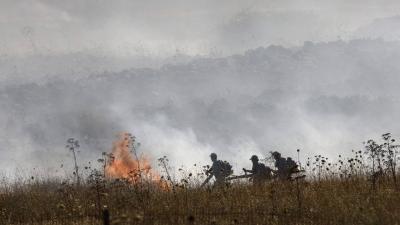The Lebanese-Israeli front has been on fire with mutual shelling and a war of attrition since October, but what distinguishes these ongoing border skirmishes is that each side has caused fires on the other's territory. The fires have resulted in material and human losses, a tactic that can inflict pain on the enemy without the need for advanced technologies.
From Lebanon's perspective, Hezbollah has launched a large number of rockets and drones towards northern Israel, many of which the Israeli army intercepted. However, the rockets and drones that slipped through Israeli defenses caused fires, as occurred in the Kiryat Shmona settlement in northern Israel and in the Kabri area, where two drones recently crashed. The fires prompted Israel to evacuate thousands of residents from the north, with the head of the firefighting department in Tiberias, Boris Eisenberg, stating that the fires consumed nearly 1,000 acres (more than 4 square kilometers) of land following a rocket strike.
Hezbollah's drones and rockets also ignited fires in the Golan Heights, particularly in the Shal settlement and the Safed area. The U.S. National Aeronautics and Space Administration (NASA) reported that images from northern Israel, captured on June 3 and 4, showed widespread damage to forests due to fires ignited by rockets from Hezbollah. The most severe forest fires were concentrated in Kiryat Shmona and surrounding areas in northern Israel, while the city of Qatzrin in the occupied Golan Heights faced intense fires. The Israeli Nature and Parks Authority announced on June 3 that more than 2,470 acres (over 10 square kilometers) of land had burned due to Hezbollah's recent attacks.
According to forest officials, Hezbollah's attacks have burned a total of 3,500 acres (more than 14 square kilometers) of Israeli land so far. Israeli media reported that more than 10 villages are threatened by these fires.
Conversely, intensive Israeli strikes on the border have ignited fires in southern Lebanon, especially as the Israeli army conducted deeper raids into Lebanese territory. Continuous bombardment has set fires in several areas in southern Lebanon, using incendiary phosphorous munitions, as occurred in the town of Al Alma al-Shab. This resulted in several olive groves being burned. Ali Abbas, a rescue worker with the Al-Mahabba Association affiliated with the Amal Movement, stated that Israel intentionally bombs forest areas with phosphorus to ignite fires. The Israeli bombardment also set fires in the northeastern town of Ma'ys al-Jabal, which extended to several landmines, leading to an expansion of the damage.
What is feared in this exchange of ignitions is the ease of the process and the potential for fires to spread to weapon storage facilities, which could lead to a wider extent of fires and increased losses. This scenario could prompt one of the parties to respond directly, elevating the current engagement rules to a level of direct confrontation. Additionally, the fires have a strategic dimension, forcing thousands of residents in border areas to leave due to the deadly threat posed by these fires.




